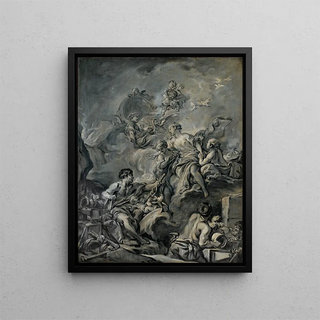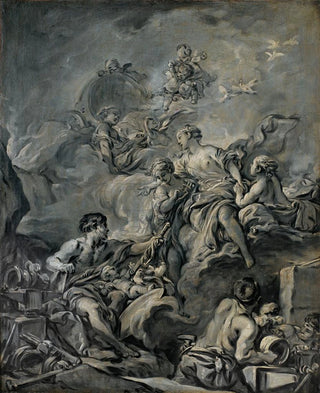Art print | Venus orders weapons from Vulcan - François Boucher Source: Reproduction | Vénus commande des armes à Vulcain - François Boucher


View from behind

Frame (optional)
Art print Venus commanding weapons to Vulcan - François Boucher – Captivating Introduction
In the enchanting universe of Rococo art, the work "Venus commanding weapons to Vulcan" by François Boucher stands as a radiant testament to the sensuality and elegance that define this era. Painted in the 18th century, this canvas depicts a mythological scene where the goddess of love, Venus, turns to Vulcan, the god of fire and forge, to request him to forge weapons for her. This interaction, imbued with tenderness and desire, captures the very essence of divine relationships while highlighting the beauty and delicacy of human figures. Boucher's composition, both narrative and aesthetic, invites the viewer to immerse themselves in a world where beauty and passion intertwine, revealing the subtleties of classical mythology.
Style and uniqueness of the work
Boucher's style is distinguished by his bold use of color and light, creating an atmosphere that is both warm and intimate. In "Venus commanding weapons to Vulcan," soft hues and pastel shades contribute to a dreamy ambiance, while the meticulous details of drapery and character expressions demonstrate his technical skill. Venus's posture, both graceful and assertive, juxtaposes strength and vulnerability, while Vulcan, though less prominent in the foreground, exudes a quiet power. The artwork does not merely depict a simple request; it evokes a complex dynamic between the characters, where love and power coexist. This painting, both narrative and visual, embodies the spirit of Rococo, where art becomes a reflection of human passions and divine intrigues.
The artist and his influence
François Boucher, an emblematic figure of the 18th century, knew how to mark his era with a flamboyant style that influenced many artists. A student of François Le Moyne, Boucher quickly developed an artistic signature unique to him, blending sensuality and fantasy. His fascination with mythology and nature is evident in his works, where he manages to harmon

Matte finish

View from behind

Frame (optional)
Art print Venus commanding weapons to Vulcan - François Boucher – Captivating Introduction
In the enchanting universe of Rococo art, the work "Venus commanding weapons to Vulcan" by François Boucher stands as a radiant testament to the sensuality and elegance that define this era. Painted in the 18th century, this canvas depicts a mythological scene where the goddess of love, Venus, turns to Vulcan, the god of fire and forge, to request him to forge weapons for her. This interaction, imbued with tenderness and desire, captures the very essence of divine relationships while highlighting the beauty and delicacy of human figures. Boucher's composition, both narrative and aesthetic, invites the viewer to immerse themselves in a world where beauty and passion intertwine, revealing the subtleties of classical mythology.
Style and uniqueness of the work
Boucher's style is distinguished by his bold use of color and light, creating an atmosphere that is both warm and intimate. In "Venus commanding weapons to Vulcan," soft hues and pastel shades contribute to a dreamy ambiance, while the meticulous details of drapery and character expressions demonstrate his technical skill. Venus's posture, both graceful and assertive, juxtaposes strength and vulnerability, while Vulcan, though less prominent in the foreground, exudes a quiet power. The artwork does not merely depict a simple request; it evokes a complex dynamic between the characters, where love and power coexist. This painting, both narrative and visual, embodies the spirit of Rococo, where art becomes a reflection of human passions and divine intrigues.
The artist and his influence
François Boucher, an emblematic figure of the 18th century, knew how to mark his era with a flamboyant style that influenced many artists. A student of François Le Moyne, Boucher quickly developed an artistic signature unique to him, blending sensuality and fantasy. His fascination with mythology and nature is evident in his works, where he manages to harmon






